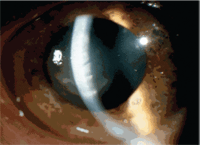Four years ago, the International Task Force published a document that detailed the best treatments for dry eye disease. In the document, the authors listed punctal occlusion as one of the best ways to treat moderate to severe dry eye symptoms and signs (stage 3 dry eye).1 The authors also suggested that inflammation must first be treated with corticosteroids and cyclosporin in successful dry eye management.2 And while inflammation should indeed be treated first, punctal occlusion should still be considered an excellent treatment option in successful dry eye disease management.

Punctal Occlusion as a Primary Treatment
In addition to keratoconjunctivitis sicca (KCS), punctal occlusion can be an ideal primary treatment for several ocular surface conditions, including neurotrophic keratitis and lagophthalmos-related exposure keratopathy.
• Neurotrophic keratitis. Anecdotal clinical evidence suggests that punctal occlusion benefits patients with neurotrophic keratitis. It has been theorized that neurotrophic eyes may have a lower or altered inflammatory mediated response, so the addition of punctal plugs could elevate tear response with fewer inflammatory mediators.3,4 One study of patients with post-LASIK neurotrophic epitheliopathy showed that punctal occlusion in combination with other treatments, such as artificial tears, cyclosporin and nutrition therapy, decreased the incidence of more significant symptoms.5
• Lagophthalmos-related exposure keratopathy. Punctual occlusion also may be useful as an initial treatment for exposure keratopathy secondary to KCS or lagophthalmos.6,7
However, exposure keratopathy from a previous cosmetic surgery will not respond as well to artificial tears or punctal plugs, and instead may require surgical repair.8
Perhaps the reason why punctal occlusion works effectively in patients with KCS or lagophthalmos-related exposure keratopathy is due to increased tear meniscus height and volume, which helps cover the exposed cornea. In one recent study, 20 dry eye patients and 20 healthy patients received punctal occlusion. Optical coherence tomography measurements of the upper and lower tear menisci were imaged at baseline as well as at one-day, four-day, seven-day and 10-day follow-up. Testing for menisci height and volume as well as tear film break-up time (TFBUT) also was performed. In the dry eye patient group, the height and volume of the upper and lower menisci were statistically larger.9 Interestingly, the patients without dry eye did not show a statistical improvement, which was likely secondary to auto-regulatory mechanisms of the tear system.9,10

Punctal plugs may prevent reactivation of HSK, as seen in this patient.
Cyclosporin and Punctal Plugs
When treating mild to moderate dry eye with punctal plugs, it is also beneficial to use targeted medications, such as loteprednol and cyclosporin.1,11 In one study, the researchers evaluated the efficacy of cyclosporin alone in dry eye patients, punctal occlusion alone and combination cyclosporin/punctal plugs.12 All three regimens were effective in treating dry eye; however, patients who received punctal plugs exhibited increased tear volume and “wetness,” and patients who received cyclosporin experienced longer periods of long-term ocular surface health. Therefore, the researchers determined that dry eye patients receive the highest therapeutic benefit from combination cyclosporin/punctal plug use.12
Keep in mind, however, that punctal plugs also may provide long-term ocular surface health. One study published in 2008 indicated that dry eye patients who had received punctal plugs seven years earlier still exhibited significantly better subjective findings and had to rely less on artificial tears than before undergoing punctal occlusion.13 Corneal and conjunctival staining as well as Schirmer testing scores also improved significantly from pre-insertion levels. Additionally, even after seven years, no complications were noted.13
Prevention of HSK Reactivation
Another study looked at the efficacy of adjunctive treatments to decrease herpes simplex keratitis (HSK) recurrences in patients with stromal HSK and dry eye disease.14 The researchers found that punctal occlusion reduced the duration of HSK recurrences as well as determined that the addition of cyclosporin to patients who already had punctal occlusion further decreased the recurrences.
The role of punctal occlusion has changed over the last several years in regard to dry eye management. Although it may be best to occlude dry eyes when the associated inflammation is also being controlled, there are numerous conditions, such as neurotrophic keratitis, lagophthalmos and even HSV keratitis reactivation, where punctal occlusion shows dramatic symptom improvement. In these instances, punctal plugs should be considered as a primary or additive treatment option. n
Dr. Karpecki is a paid consultant to Allergan, Bausch + Lomb and Odyssey Medical. Neither he nor Dr. Shechtman have any direct financial interest in the products mentioned.
1. Behrens A, Doyle JJ, Stern L, et al. Dysfunctional tear syndrome: a Delphi approach to treatment recommendations. Cornea. 2006 Sep;25(8):900-7.
2. Management and therapy of dry eye disease: Report of the Management and Therapy Subcommittee of the International Dry Eye WorkShop (2007). Ocul Surf. 2007 Apr;5(2):163-78.
3. Schulte-Herbrüggen O, Braun A, Rochlitzer S, et al. Neurotrophic factors––a tool for therapeutic strategies in neurological, neuropsychiatric and neuroimmunological diseases? Curr Med Chem. 2007;14(22):2318-29.
4. Chen HJ, Pires RT, Tseng SC. Amniotic membrane transplantation for severe neurotrophic corneal ulcers. Br J Ophthalmol. 2000 Aug;84(8):826-33.
5. Ambrosio R Jr, Tervo T. LASIK-associated dry eye and neurotrophic epitheliopathy: pathophysiology and strategies for prevention and treatment. J Refract Surg. 2008 Apr;24(4):396-407.
6. Putterman AM. Canaliculectomy in the treatment of keratitis sicca. Ophthalmic Surg. 1991 Aug;22(8):478-80.
7. Latkany RL, Lock B, Speaker M. Nocturnal lagophthalmos: an overview and classification. Ocul Surf. 2006 Jan;4(1):44-53.
8. Miedziak Al, Gottsch JD, Lliff NT. Exposure keratopathy after cosmetic CO2 laser skin resurfacing. Cornea. 2000 Nov;19(6):846-8.
9. Chen F, Shen M, Chen W, et al. Tear meniscus volume in dry eye after punctal occlusion. Invest Ophthalmol Vis Sci. 2010 Apr;51(4):1965-9.
10. Yen MT, Pflugfelder SC, Feuer WJ. The effect of punctal occlusion on tear production, tear clearance, and ocular surface sensation in normal subjects. Am J Ophthalmol. 2001 Mar;131(3):314-23.
11. Pflugfelder SC, Maskin SL, Anderson B, et al. A randomized, double-masked, placebo-controlled, multicenter comparison of loteprednol etabonate ophthalmic suspension, 0.5%, and placebo for treatment of keratoconjunctivitis sicca in patients with delayed tear clearance. Am J Ophthalmol. 2004 Sep;138(3):444-57.
12. Roberts CW, Carniglia PE, Brazzo BG. Comparison of topical cyclosporine, punctal occlusion, and a combination for the treatment of dry eye. Cornea. 2007 Aug;26(7):805-9.
13. Giovangoli D, Graham SJ. Inferior punctal occlusion with removable silicone punctal plugs in the treatment of dry-eye related contact lens discomfort. J Am Optom Assoc. 1992 Jul;63(7):481-5.
14. Sheppard JD, Wertheimer ML, Scoper SV. Modalities to decrease stromal herpes simplex keratitis reactivation rates. Arch Ophthalmol. 2009 Jul;127(7):852-6.

